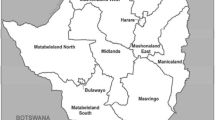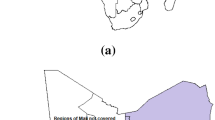Abstract
Children in less developed countries die from relatively small number of infectious disease, some of which epidemiologically overlap. Using self-reported illness data from the 2000 Malawi Demographic and Health Survey, we applied a random effects multinomial model to assess risk factors of childhood co-morbidity of fever, diarrhoea and pneumonia, and quantify area-specific spatial effects. The spatial structure was modelled using the conditional autoregressive prior. Various models were fitted and compared using deviance information criterion. Inference was Bayesian and was based on Markov Chain Monte Carlo simulation techniques. We found spatial variation in childhood co-morbidity and determinants of each outcome category differed. Specifically, risk factors associated with child co-morbidity included age of the child, place of residence, undernutrition, bednet use and Vitamin A. Higher residual risk levels were identified in the central and southern–eastern regions, particularly for fever, diarrhoea and pneumonia; fever and pneumonia; and fever and diarrhoea combinations. This linkage between childhood health and geographical location warrants further research to assess local causes of these clusters. More generally, although each disease has its own mechanism, overlapping risk factors suggest that integrated disease control approach may be cost-effective and should be employed.




Similar content being viewed by others
Abbreviations
- CAR:
-
Conditional autoregressive
- CI:
-
Confidence Interval; Credible Interval
- DIC:
-
Deviance information criterion
- EA:
-
Enumeration areas
- ITN:
-
Insecticide treated nets
- MCMC:
-
Markov Chain Monte Carlo
- MDHS:
-
Malawi demographic and health Survey
- ROR:
-
Relative odds ratio
References
Black RE, Morris SS, Bryce J. Where and why are 10 million children dying every year? Lancet 2003;361:2226–34
Mulholland K. Commentary: comorbidity as a factor in child health and child survival in developing countries. Int J Epidemiol 2005;34:375–7
National Statistical Office, ORC Macro. Malawi Demographic and Health Survey 2004: Preliminary report. Zomba, Malawi: NSO; 2005.
World Health Statistics. Country Health System Fact Sheet 2006– Malawi. Url: [http://www.who.int/whosis/en/
Fenn B, Morris S, Black RE. Comorbidity in childhood in Ghana: magnitude, associated factors and impact on mortality. Int J Epidemiol 2005;34:368–75
Källander K, Nsungwa-Sabiiti J, Peterson S. Symptom overlap for malaria and pneumonia-policy implications for home management strategies. Acta Tropic 2004;90:211–4
Sachs JD, McArthur JW. The Millennium Project: a plan for meeting the Millennium Development Goals. Lancet 2005;365:347–53
Richardson S, Abellan JJ, Best N. Bayesian spatio-temporal analysis of joint patterns of male and female lung cancer risks in Yorkshire (UK). Stat Methods Med Res 2006;15:385–407
Held L, Natario I, Fenton SE, Rue H, Becker N. Towards joint disease mapping. Stat Methods Med Res 2005;14:61–82
Raso G, Vounatsou P, Singer BH, N’Goran EK. An integrated approach for risk profiling and spatial prediction of Schistosoma mansoni-hookworm coinfection. PNAS 2006;103:6934–9
Elliot P, Wakefield J, Best N, Briggs DJ (eds). Spatial epidemiology-methods and applications. London: Oxford University Press; 2000
National Statistical Office, ORC Macro. Malawi Demographic and Health Survey 2000. Zomba, Malawi: NSO; 2001
Kandala N-B. Bayesian geoadditive modelling of childhood morbidity in Malawi. Appl Stoch Models Busin Industr 2006; 22: 139–54
Kandala N-B, Magadi MA, Madise NJ. An investigation of district spatial variations of childhood diarrhoea and fever morbidity in Malawi. Soc Sci Med 2006;62:1138–52
Jin X, Carlin BP, Banerjee S. Generalized hierarchical multivariate CAR models for areal data. Biometrics 2005;61:950–61
Gelfand AE, Vounatsou P. Proper multivariate conditional autoregressive models for spatial data analysis. Biostat 2003;4:11–25
Fahrmeir L, Tutz G. Multivariate statistical modelling based on generalized linear models. New York: Springer-Verlag; 2001.
Vounatsou P, Smith T, Gelfand AE. Spatial modelling of multinomial data with latent structure: an application to geographical mapping of human gene and haplotype frequencies. Biostat 2000;1:177–89
Fahrmeir L, Lang S. Bayesian semiparametric regression analysis of multicategorical time-space data. Ann Inst Stat Math 2001;53:11–30
Lang S, Brezger A. Bayesian P-splines. J Comput Graph Stat 2004;13:183–212
Dean C, MacNab YC. Modelling of rates over a hierarchical health administrative structure. Can J Stat 2001;29:405–19
Banerjee S, Carlin BP, Gelfand AE. Hierarchical modeling and analysis for spatial data. Chapman and Hall/CRC: London; 2004
Mugglin AS, Carlin BP, Gelfand AE. Fully model-based approaches for spatially misaligned data. JASA 2000;95:877–87
Besag J, York J, Mollie A. Bayesian image restoration with two applications in spatial statistics (with discussion). Ann Inst Stat Math 1991;43:1–59
Spiegelhalter DJ, Best NG, Carlin BP, van der Linde A. Bayesian measures of model complexity and fit. J Royal Stat Soc B (with discussion) 2002;64:583–639
Brezger A, Kneib T, Lang S. BayesX: Analyzing Bayesian structured additive regression models. J Stat Soft 2005;14:11
Joint United Nations Programme on HIV/AIDS (UNAIDS). 2006 Report on the global AIDS epidemic. A UNAIDS 10th anniversary special edition; 2006. Available online at [http://www.unaids.org/en/HIV_data/2006GlobalReport/default.asp.
Kazembe LN. Spatial analysis of malariometric indicators in Malawi. PhD Thesis. University of KwaZulu-Natal, South Africa; 2006
Kazembe LN, Kleinschmidt I, Holtz TH, Sharp BL. Spatial analysis and mapping of malaria risk in Malawi using point referenced prevalence of infection data. Int J Health Geogr 2006;5:41
Caulfield LE, de Onis M, Lössner M, Black RE. Undernutrition as an underlying cause of child deaths associated with diarrhea, pneumonia, malaria, and measles. Am J Clin Nutr 2004;80:193–8
Benson T, Chamberlin J, Rhinehart I. An investigation of the spatial determinants of the local prevalence of poverty in rural Malawi. Food Policy 2005;30:532–50
World Bank. Profile of poverty in Malawi, 1998. Poverty analysis of the Malawian Integrated Household Survey, 1997–1998. Washington, D.C: The World Bank; 2000
Spiegelhalter DJ, Thomas A, Best NG. WinBUGS Version 1.2 User Manual. MRC Biostatistics Unit. University of London; 1999
Lambert PC. Comment on article by Browne and Draper. Bayesian Anal 2006;1:543–6
Lambert PC, Sutton AJ, Burton PR, Abrams KR, Jones DR. How vague is vague? A simulation study of the impact of the use of vague prior distributions in MCMC using WinBUGS. Stat Med 2005;24:2401–28
Gelman A. Prior distributions for variance parameters in hierarchical models. Bayesian Analysis 2006;1:515–34
Boerma JT, Black RE, Sommerfelt AE, Rustein SO, Bicego GT. Accuracy and completeness of mother’s recall of diarrhoea occurence in pre-school children in demographic and health surveys. Int J Epidemiol 1991;20:1073–80
Acknowledgements
I would like to acknowledge the research training grant received from WHO/TDR and support from Medical Research Council, Durban, South Africa during my PhD training. I also acknowledge permission granted by MEASURE DHS to use the 2000 Malawi DHS data under the project- Spatial analysis of malariometric indicators in Malawi. We thank the anonymous reviewers for valuable comments on the earlier manuscript.
Author information
Authors and Affiliations
Corresponding author
Rights and permissions
About this article
Cite this article
Kazembe, L.N., Namangale, J.J. A Bayesian multinomial model to analyse spatial patterns of childhood co-morbidity in Malawi. Eur J Epidemiol 22, 545–556 (2007). https://doi.org/10.1007/s10654-007-9145-y
Received:
Accepted:
Published:
Issue Date:
DOI: https://doi.org/10.1007/s10654-007-9145-y




